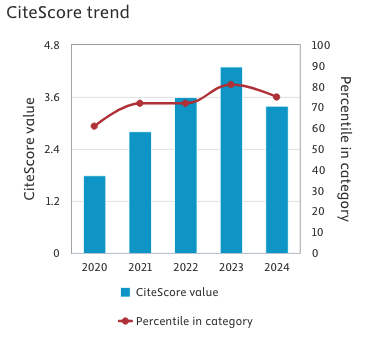Retrospective analysis of outcomes and complications after Korus hemiarthroplasty in elderly patients with neck femur fractures
Keywords:
Femur fracture, hemiarthroplasty, Korus, Hydroxyapatite coating, uncemented stemAbstract
Background: Femoral neck fractures (FNF) is one of the most common traumatic events in elderly patients: the choice of an appropriate treatment is necessary to decrease the related mortality and to achieve the best possible outcomes. Nowadays, it is still debated whether or not to cement the stem in hemiarthroplasty and above all, which stem to use to best respect the integrity of the elderly bone.
Methods: From January 2017 to December 2019, a bi-centric study utilizing prospectively collected databases of elderly patients with FNF treated with uncemented Korus stem hemiarthroplasty was performed. Patients were preoperatively classified according to ASA score. Patients’ clinical and X-ray follow-up was at 1, 3, 6, 12 months. Harris Hip Score (HHS) was used for analysed clinical improvement. On the X-rays, we analysed iatrogenic fractures, osteolysis area and radiolucent lines in the stem region during follow up.
Results: 233 patients were identified. Median follow-up was 12 months. Over time, 51 patients died (21.88%). Mean age was 89,56 ± 6,25. 75 patients had ASA score of 2 (32.3%), 102 patients a score of 3 (43.7%), 56 an ASA score of 4 (24,0%). The main Harris hip score was 68,66 ± 8.53 at 1 month of follow-up, 71,74 ± 9.65 after 3 months, 72,50 ± 10.66 at 6 months and 75,61 ± 9.63 at 12 months control.
Conclusions: Hydroxyapatite coated stem with an accurate design guarantee early fixation, good clinical and radiographic results, low rate of re-intervention and mortality rate and a satisfying return to pre-injury activities.
References
[2] M. Ehlinger et al., “Early prediction of femoral head avascular necrosis following neck fracture,” Orthop. Traumatol. Surg. Res., vol. 97, no. 1, pp. 79–88, 2011.
[3] B.-W. Min, K.-J. Lee, K.-C. Bae, S.-W. Lee, S.-J. Lee, and J.-H. Choi, “Result of internal fixation for stable femoral neck fractures in elderly patients,” Hip pelvis, vol. 28, no. 1, pp. 43–48, 2016.
[4] T. Antonios, N. Bakti, O. Nzeako, P. Mohanlal, and B. Singh, “Journal of Clinical Orthopaedics and Trauma Outcomes following fi xation for proximal humeral fractures,” J. Clin. Orthop. Trauma, vol. 10, no. 3, pp. 468–473, 2019.
[5] P. Maniscalco, F. Quattrini, C. Ciatti. A Preliminary experience with a new intramedullary nail for trochanteric fractures. Progress in Nutrition 2020; Vol. 22, Supplement 1: 00-00
[6] F. Rivera, F. Leonardi, and P. Maniscalco, “Uncemented fully hydroxyapatite-coated hip stem for intracapsular femoral neck fractures in osteoporotic elderly patients : a multicenter study,” arthroplasy today, vol. 1, no. 3, 2015.
[7] R. Geesink and H. NH, “Six-year results of hydroxyapatite-coated total hip replacement,” Bone Joint J., vol. 77, no. 4, 1995.
[8] R. G. Molli, A. Lombardi, Keith, J. Adams, and M. A. Sneller, “Short Tapered Stem Reduces Intraoperative Complications in Primary Total Hip Arthroplasty,” Clin. Orthop. Relat. Res., vol. 470, pp. 450–461, 2012.
[9] P. Maniscalco, E. Poggiali, F. Quattrini. Proximal femur fractures in COVID-19 emergency: the experience of two Orthopedics and Traumatology Departments in the first eight weeks of the Italian epidemic. Acta Biomed 2020; Vol. 91, N. 2: 89-96
[10] Maniscalco P, Quattrini F, Ciatti C, Ghidoni L, Ghidoni G, Burgio V, Pogliacomi F, Vaienti E, Ceccarelli F. Neck modularity in total hip arthroplasty: a retrospective study of nine hundred twenty-eight titanium neck implants with a maximum follow-up of eighteen years. Int Orthop. 2020 Jun 29. doi: 10.1007/s00264-020-04686-8. Epub ahead of print. PMID: 32601721.
[11] G. Sessa et al., “Bone mineral density as a marker of hip implant longevity : a prospective assessment of a cementless stem with dual-energy X-ray absorptiometry at twenty years,” 2018.
[12] G. Kastanis, A. Topalidou, K. Alpantaki, M. Rosiadis, and K. Balalis, “Is the ASA score in geriatric hip fractures a predictive factor for complications and readmission?,” Scientifica (Cairo)., vol. 2016, 2016.
[13] S. EISKJAER and S. E. ØSTGÅRD, “Risk Factors Influencing Mortality After Bipolar Hemiarthroplasty in the Treatment of Fracture of the Femoral Neck,” Clin. Orthop. Relat. Res., vol. 270, 1991.
[14] H. Doruk, M. R. Mas, C. Yıldız, A. Sonmez, and V. Kýrdemir, “The effect of the timing of hip fracture surgery on the activity of daily living and mortality in elderly,” Arch. Gerontol. Geriatr., vol. 39, no. 2, pp. 179–185, 2004.
[15] T. Yonezawa, K. Yamazaki, T. Atsumi, and S. Obara, “Influence of the timing of surgery on mortality and activity of hip fracture in elderly patients,” J. Orthop. Sci., vol. 14, no. 5, pp. 566–573, 2009.
[164] D. J. Costain, S. L. Whitehouse, N. L. Pratt, S. E. Graves, P. Ryan, and R. W. Crawford, “Perioperative mortality after hemiarthroplasty related to fixation method,” Acta Orthop., vol. 82, no. 3, pp. 275–281, Jun. 2011.
[175] L. Dorr, Z. Wan, M. Song, and A. Ranawat, “Bilateral Total Hip Arthroplasty Comparing Hydroxyapatite Coating to Porous-Coated Fixation,” J. Arthroplasty, vol. 13, no. 7, pp. 729–736, 1998.
[16] Landor, I., Vavrik, P., Sosna, A. et al. Hydroxyapatite porous coating and the osteointegration of the total hip replacement. Arch Orthop Trauma Surg 127, 81–89 (2007). https://doi.org/10.1007/s00402-006-0235-1
Downloads
Published
Issue
Section
License
Copyright (c) 2021 Publisher

This work is licensed under a Creative Commons Attribution-NonCommercial 4.0 International License.
This is an Open Access article distributed under the terms of the Creative Commons Attribution License (https://creativecommons.org/licenses/by-nc/4.0) which permits unrestricted use, distribution, and reproduction in any medium, provided the original work is properly cited.
Transfer of Copyright and Permission to Reproduce Parts of Published Papers.
Authors retain the copyright for their published work. No formal permission will be required to reproduce parts (tables or illustrations) of published papers, provided the source is quoted appropriately and reproduction has no commercial intent. Reproductions with commercial intent will require written permission and payment of royalties.






